Third Body Wear of UHMWPE-on-PEEK-OPTIMA™
Abstract
:1. Introduction
2. Materials and Methods
2.1. Materials
2.2. Methods
2.2.1. Damage Simulation: Third Body Damage with PMMA Cement Particles
2.2.2. Damage Simulation: Third Body Damage Created Using a Diamond Stylus
2.2.3. Pin-on-Plate Wear Simulation
3. Results
3.1. Third Body Damage with PMMA Cement Particles
3.2. Third Body Damage Created Using a Diamond Stylus
4. Discussion
5. Conclusions
Author Contributions
Funding
Acknowledgments
Conflicts of Interest
Appendix A
| Intended Lip Height of Scratches | PEEK-OPTIMA™ | Cobalt Chrome | ||
|---|---|---|---|---|
| Weight Applied to Diamond Stylus (Kg) | Actual Lip Height of Scratches (µm) | Weight Applied to Diamond Stylus (Kg) | Actual Lip Height of Scratches (µm) | |
| 1 µm | 0.51 | 1.11 ± 0.38 | 2.08 | 1.35 ± 0.09 |
| 2 µm | 0.71 | 2.82 ± 0.57 | 2.99 | 2.19 ± 0.15 |
| 4 µm | 1.02 | 4.22 ± 1.12 | 4.90 | 4.25 ± 0.59 |
References
- National Joint Registry 16th Annual Report. 2018. Available online: https://reports.njrcentre.org.uk/Portals/0/PDFdownloads/NJR%2016th%20Annual%20Report%202019.pdf (accessed on 10 March 2020).
- Bourne, R.B.; Chesworth, B.M.; Davis, A.M.; Mahomed, N.N.; Charron, K.D.J. Patient satisfaction after total knee arthroplasty: Who is satisfied and who is not? Clin. Orthop. Relat. Res. 2010, 468, 57–63. [Google Scholar] [CrossRef] [PubMed] [Green Version]
- Cowie, R.M.; Briscoe, A.; Fisher, J.; Jennings, L.M. PEEK-OPTIMA™ as an alternative to cobalt chrome in the femoral component of total knee replacement: A preliminary study. Proc. Inst. Mech. Eng. Part H J. Eng. Med. 2016, 230, 1008–1015. [Google Scholar] [CrossRef] [PubMed] [Green Version]
- Rankin, K.E.; Dickinson, A.S.; Briscoe, A.; Browne, M. Does a PEEK Femoral TKA Implant Preserve Intact Femoral Surface Strains Compared with CoCr? A Preliminary Laboratory Study. Clin. Orthop. Relat. Res. 2016, 474, 2405–2413. [Google Scholar] [CrossRef] [PubMed] [Green Version]
- de Ruiter, L.; Janssen, D.; Briscoe, A.; Verdonschot, N. The mechanical response of a polyetheretherketone femoral knee implant under a deep squatting loading condition. Proc. Inst. Mech. Eng. Part H J. Eng. Med. 2017, 231, 1204–1212. [Google Scholar] [CrossRef] [PubMed] [Green Version]
- de Ruiter, L.; Janssen, D.; Briscoe, A.; Verdonschot, N. A preclinical numerical assessment of a polyetheretherketone femoral component in total knee arthroplasty during gait. J. Exp. Orthop. 2017, 4, 3. [Google Scholar] [CrossRef] [Green Version]
- East, R.H.; Briscoe, A.; Unsworth, A. Wear of PEEK-OPTIMA® and PEEK-OPTIMA®-Wear Performance articulating against highly cross-linked polyethylene. Proc. Inst. Mech. Eng. Part H J. Eng. Med. 2015, 229, 187–193. [Google Scholar] [CrossRef]
- Cowie, R.M.; Briscoe, A.; Fisher, J.; Jennings, L.M. Wear and Friction of UHMWPE-on-PEEK OPTIMA™. J. Mech. Behav. Biomed. Mater. 2019, 89, 65–71. [Google Scholar] [CrossRef]
- Du, Z.; Zhu, Z.; Yue, B.; Li, Z.; Wang, Y. Feasibility and Safety of a Cemented PEEK-on-PE Knee Replacement in a Goat Model: A Preliminary Study. Artif. Organs 2018, 42, E204–E214. [Google Scholar] [CrossRef]
- Meng, X.; Du, Z.; Wang, Y. Characteristics of wear particles and wear behavior of retrieved PEEK-on-HXLPE total knee implants: A preliminary study. RSC Adv. 2018, 8, 30330–30339. [Google Scholar] [CrossRef] [Green Version]
- Jennings, L.M.; Al-Hajjar, M.; Brockett, C.L.; Williams, S.; Tipper, J.L.; Ingham, E.; Fisher, J. (iv) Enhancing the safety and reliability of joint replacement implants. Orthop. Trauma 2012, 26, 246–252. [Google Scholar] [CrossRef] [Green Version]
- Wang, A.; Essner, A. Three-body wear of UHMWPE acetabular cups by PMMA particles against CoCr, alumina and zirconia heads in a hip joint simulator. Wear 2001, 250, 212–216. [Google Scholar] [CrossRef]
- Barbour, P.; Stone, M.; Fisher, J. A hip joint simulator study using new and physiologically scratched femoral heads with ultra-high molecular weight polyethylene acetabular cups. Proc. Inst. Mech. Eng. Part H J. Eng. Med. 2000, 214, 569–576. [Google Scholar] [CrossRef] [PubMed]
- Ries, M.D.; Salehi, A.; Widding, K.; Hunter, G. Polyethylene wear performance of oxidized zirconium and cobalt-chromium knee components under abrasive conditions. JBJS 2002, 84, 129–135. [Google Scholar] [CrossRef]
- Minakawa, H.; Stone, M.; Wroblewski, B.; Lancaster, J.; Ingham, E.; Fisher, J. Quantification of third-body damage and its effect on UHMWPE wear with different types of femoral head. J. Bone Jt. Surg. Br. Vol. 1998, 80, 894–899. [Google Scholar] [CrossRef]
- Cowie, R.M.; Carbone, S.; Aiken, S.; Cooper, J.J.; Jennings, L.M. Influence of third-body particles originating from bone void fillers on the wear of ultra-high-molecular-weight polyethylene. Proc. Inst. Mech. Eng. Part H J. Eng. Med. 2016, 230, 775–783. [Google Scholar] [CrossRef] [Green Version]
- Niki, Y.; Matsumoto, H.; Otani, T.; Tomatsu, T.; Toyama, Y. How much sterile saline should be used for efficient lavage during total knee arthroplasty? Effects of pulse lavage irrigation on removal of bone and cement debris. J. Arthroplast. 2007, 22, 95–99. [Google Scholar] [CrossRef]
- Cowie, R.M.; Jennings, L.M. Data Associated with ‘Third Body Wear of UHMWPE-on-PEEK-OPTIMA™’; University of Leeds: Leeds, UK, 2020. [Google Scholar] [CrossRef]
- Galvin, A.; Kang, L.; Tipper, J.; Stone, M.; Ingham, E.; Jin, Z.; Fisher, J. Wear of crosslinked polyethylene under different tribological conditions. J. Mater. Sci. Mater. Med. 2006, 17, 235–243. [Google Scholar] [CrossRef]
- ISO 4288:1996. Geometrical Product Specifications (GPS)—Surface Texture: Profile Method—Rules and Procedures for the Assessment of Surface Texture; ISO: Geneva, Switzerland, 1996. [Google Scholar]
- Grupp, T.M.; Meisel, H.-J.; Cotton, J.A.; Schwiesau, J.; Fritz, B.; Blömer, W.; Jansson, V.J.B. Alternative bearing materials for intervertebral disc arthroplasty. Biomaterials 2010, 31, 523–531. [Google Scholar] [CrossRef]
- Brockett, C.L.; John, G.; Williams, S.; Jin, Z.; Isaac, G.H.; Fisher, J. Wear of ceramic-on-carbon fiber-reinforced poly-ether ether ketone hip replacements. J. Biomed. Mater. Res. Part B Appl. Biomater. 2012, 100, 1459–1465. [Google Scholar] [CrossRef]
- Isaac, G.; Atkinson, J.; Dowson, D.; Kennedy, P.; Smith, M. The causes of femoral head roughening in explanted Charnley hip prostheses. Proc. Inst. Mech. Eng. Part H J. Eng. Med. 1987, 16, 167–173. [Google Scholar] [CrossRef]
- Lancaster, J.; Dowson, D.; Isaac, G.; Fisher, J. The wear of ultra-high molecular weight polyethylene sliding on metallic and ceramic counterfaces representative of current femoral surfaces in joint replacement. Proc. Inst. Mech. Eng. Part H J. Eng. Med. 1997, 211, 17–24. [Google Scholar] [CrossRef] [PubMed]
- Tipper, J.; Ingham, E.; Hailey, J.; Besong, A.; Fisher, J.; Wroblewski, B.; Stone, M. Quantitative analysis of polyethylene wear debris, wear rate and head damage in retrieved Charnley hip prostheses. J. Mater. Sci. Mater. Med. 2000, 11, 117–124. [Google Scholar] [CrossRef] [PubMed]
- Jones, V.; Williams, I.; Auger, D.; Walsh, W.; Barton, D.; Stone, M.; Fisher, J. Quantification of third body damage to the tibial counterface in mobile bearing knees. Proc. Inst. Mech. Eng. Part H J. Eng. Med. 2001, 215, 171–179. [Google Scholar] [CrossRef] [PubMed]
- Bowsher, J.; Shelton, J. A hip simulator study of the influence of patient activity level on the wear of crosslinked polyethylene under smooth and roughened femoral conditions. Wear 2001, 250, 167–179. [Google Scholar] [CrossRef]
- Cowie, R.M.; Aiken, S.S.; Cooper, J.J.; Jennings, L.M. The Influence of a Calcium Sulfate Bone Void Filler on the Third Body Damage and Polyethylene Wear of Total Knee Replacements. Bone Jt. Res. 2019, 8, 65–72. [Google Scholar] [CrossRef]
- Fisher, J.; McEwen, H.M.; Tipper, J.L.; Galvin, A.L.; Ingram, J.; Kamali, A.; Stone, M.H.; Ingham, E. Wear, debris, and biologic activity of cross-linked polyethylene in the knee: Benefits and potential concerns. Clin. Orthop. Relat. Res. 2004, 428, 114–119. [Google Scholar] [CrossRef]
- Kurtz, S.M. Chapter 3—Packaging and Sterilization of UHMWPE. In UHMWPE Biomaterials Handbook, 2nd ed.; Kurtz, S.M., Ed.; Academic Press: Boston, MA, USA, 2009; pp. 21–30. [Google Scholar]
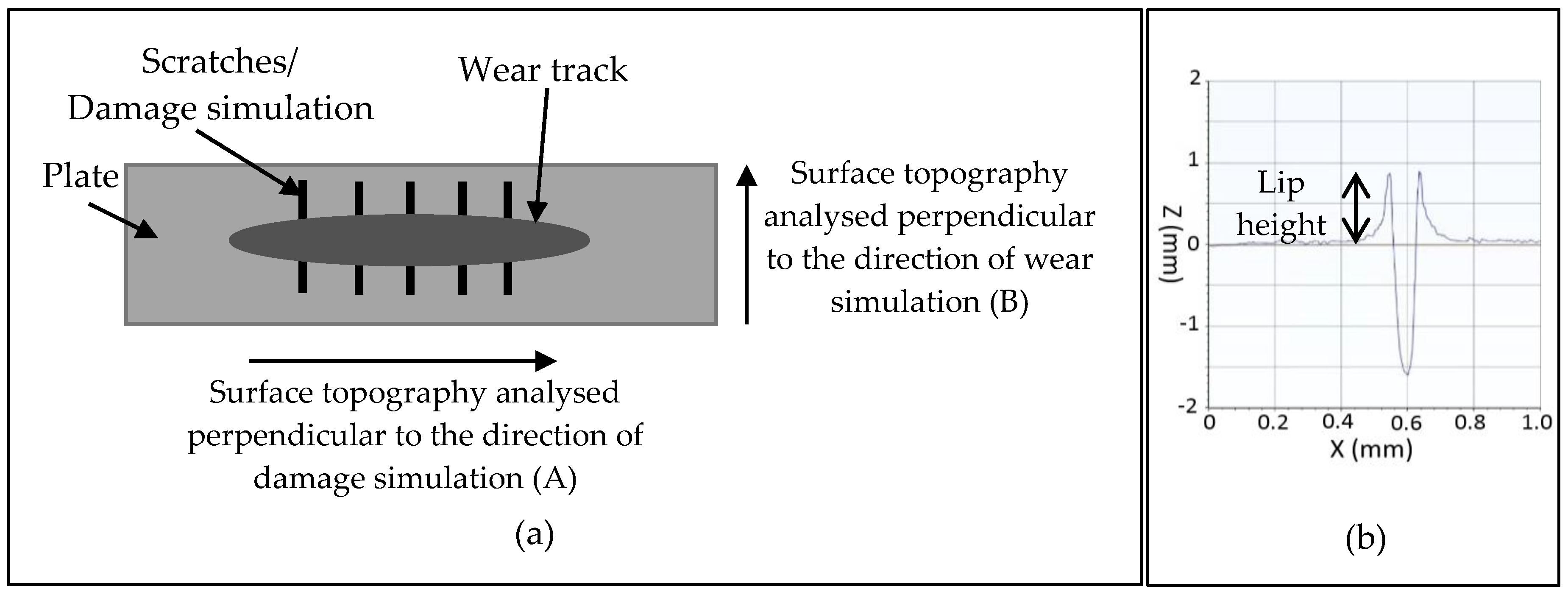
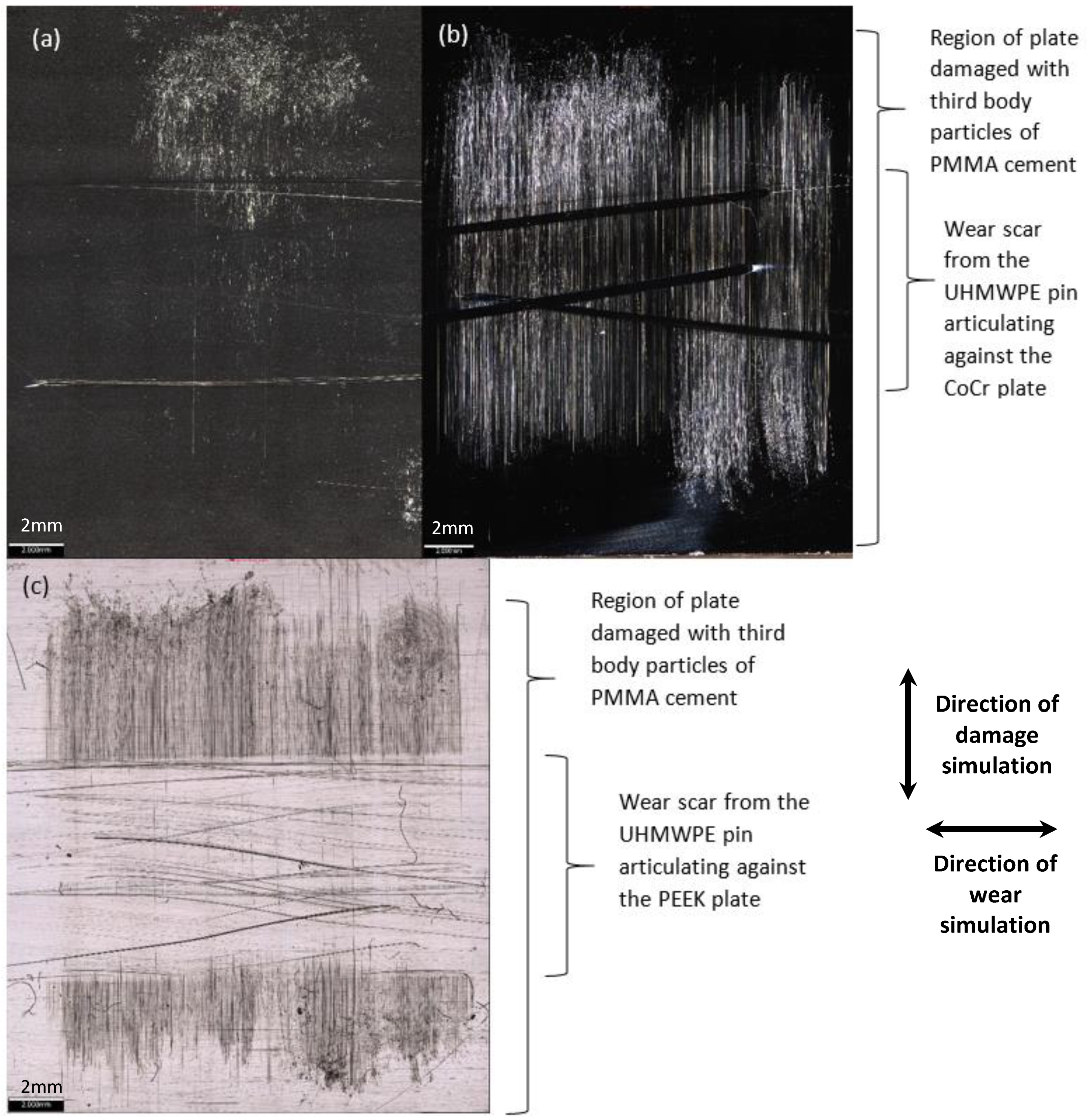
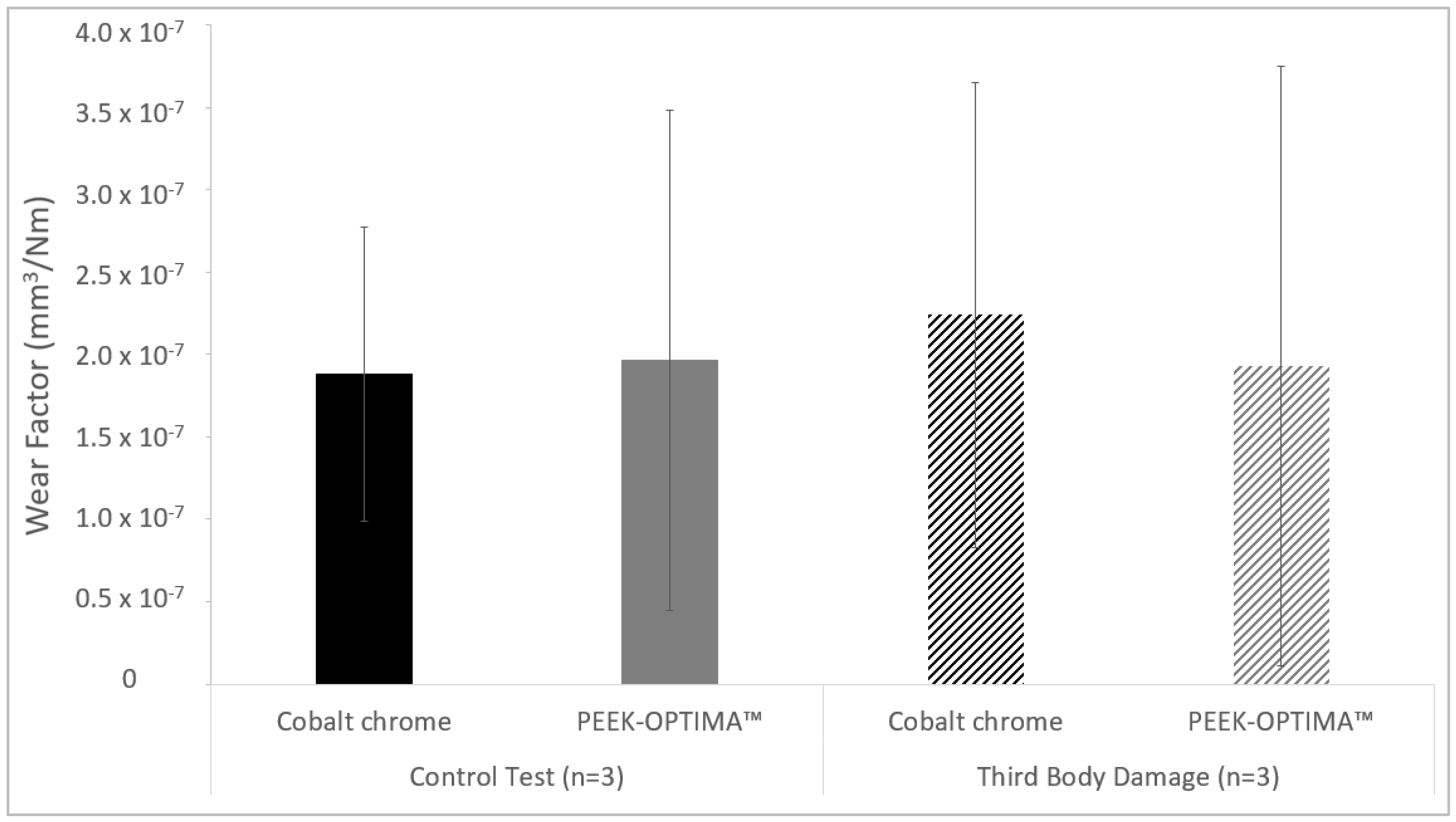

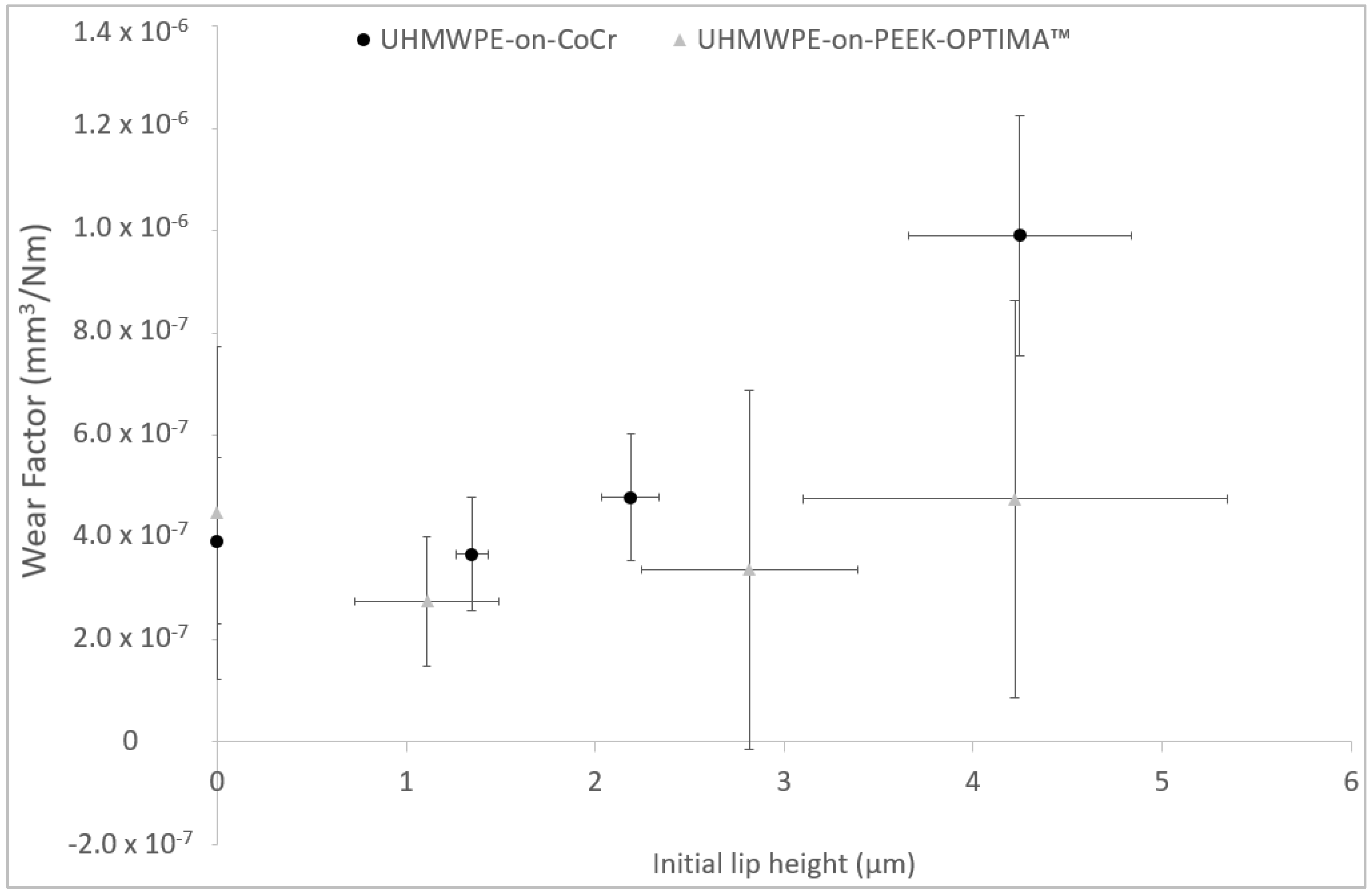
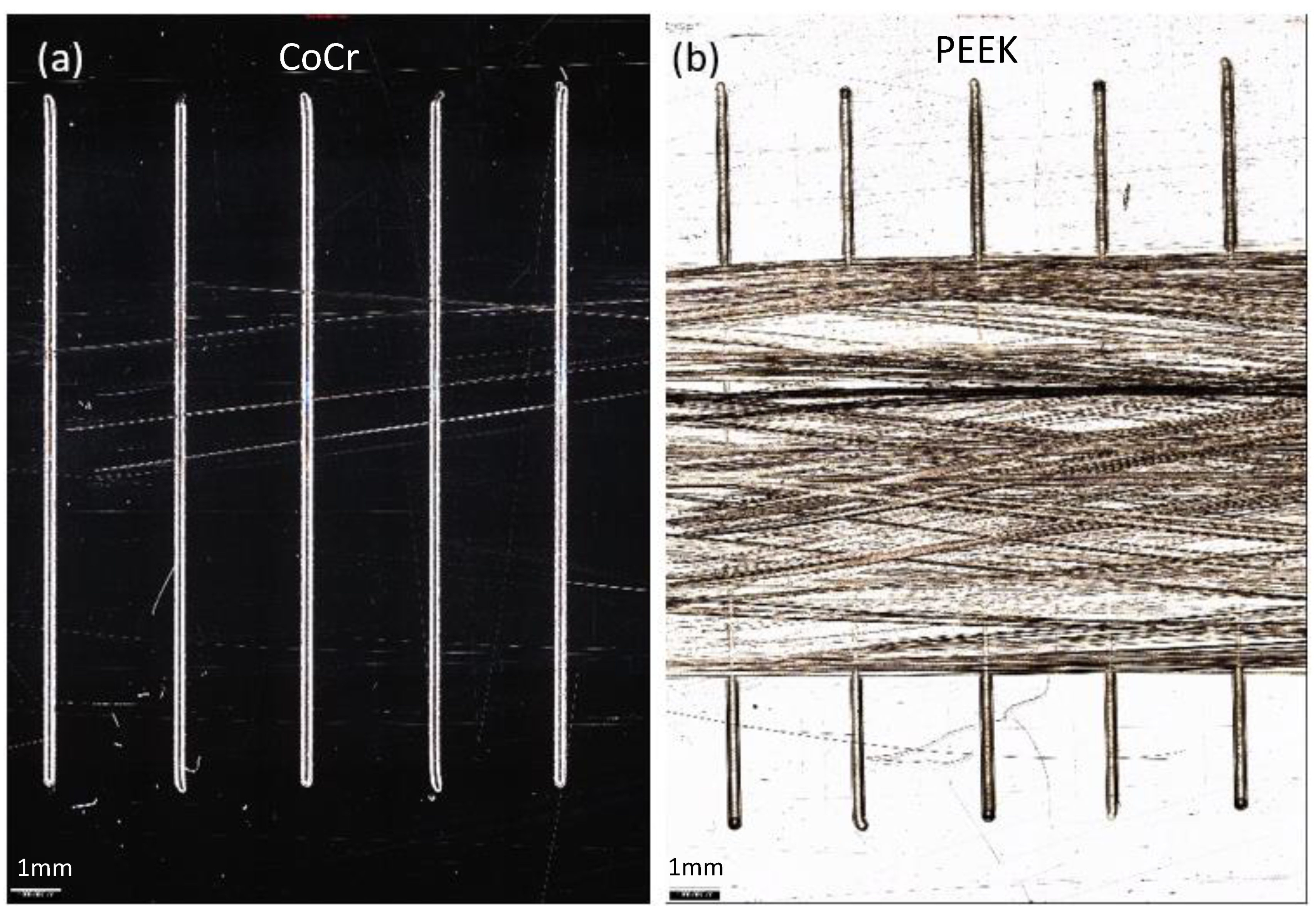
| Direction | Cobalt Chrome | PEEK-OPTIMA™ | |||||
|---|---|---|---|---|---|---|---|
| Pre-Test | After Damage Simulation with Particles | After Wear Simulation | Pre-Test | After Damage Simulation with Particles | After Wear Simulation | ||
| Control test | Perpendicular to damage simulation (A) | 0.013 ± 0.001 | 0.014 ± 0.004 | 0.014 ± 0.001 * | 0.019 ± 0.006 | ||
| Perpendicular to wear test (B) | 0.013 ± 0.000 | 0.028 ± 0.030 | 0.019 ± 0.001 * | 0.092 ± 0.159 * | |||
| Damage simulation | Perpendicular to damage simulation (A) | 0.011 ± 0.014 | 0.012 ± 0.015 | 0.011 ± 0.009 | 0.006 ± 0.002 | 0.054 ± 0.006 * | 0.018 ± 0.008 |
| Perpendicular to wear test (B) | 0.011 ± 0.015 | 0.012 ± 0.016 | 0.014 ± 0.004 | 0.018 ± 0.001 | 0.023 ± 0.002 * | 0.098 ± 0.164 | |
| Lip Height (µm) | Cobalt Chrome | PEEK-OPTIMA™ | ||
|---|---|---|---|---|
| Pre-Test | Post-Test | Pre-Test | Post-Test | |
| 1 | 1.35 ± 0.09 | 1.23 ± 0.16 | 1.11 ± 0.38 | 0.66 ± 0.66 * |
| 2 | 2.19 ± 0.15 | 1.99 ± 0.16 | 2.82 ± 0.57 * | 1.31 ± 0.70 * |
| 4 | 4.25 ± 0.59 | 4.13 ± 0.44 | 4.22 ± 1.12 | 1.79 ± 1.02 * |
| Lip Height (µm) | Cobalt Chrome | PEEK-OPTIMA™ | ||
|---|---|---|---|---|
| Pre-Test | Post-Test | Pre-Test | Post-Test | |
| 0 | 0.004 ± 0.001 | 0.027 ± 0.031 | 0.019 ± 0.004 * | 0.540 ± 0.236 * |
| 1 | 0.004 ± 0.001 | 0.008 ± 0.004 | 0.030 ± 0.012 * | 0.729 ± 0.327 * |
| 2 | 0.004 ± 0.001 | 0.019 ± 0.016 | 0.025 ± 0.007 * | 0.616 ± 0.506 * |
| 4 | 0.004 ± 0.001 | 0.019 ± 0.026 | 0.025 ± 0.008 * | 0.839 ± 0.519 * |
© 2020 by the authors. Licensee MDPI, Basel, Switzerland. This article is an open access article distributed under the terms and conditions of the Creative Commons Attribution (CC BY) license (http://creativecommons.org/licenses/by/4.0/).
Share and Cite
Cowie, R.M.; Pallem, N.M.; Briscoe, A.; Jennings, L.M. Third Body Wear of UHMWPE-on-PEEK-OPTIMA™. Materials 2020, 13, 1264. https://doi.org/10.3390/ma13061264
Cowie RM, Pallem NM, Briscoe A, Jennings LM. Third Body Wear of UHMWPE-on-PEEK-OPTIMA™. Materials. 2020; 13(6):1264. https://doi.org/10.3390/ma13061264
Chicago/Turabian StyleCowie, Raelene M., Naveen Manikya Pallem, Adam Briscoe, and Louise M. Jennings. 2020. "Third Body Wear of UHMWPE-on-PEEK-OPTIMA™" Materials 13, no. 6: 1264. https://doi.org/10.3390/ma13061264





